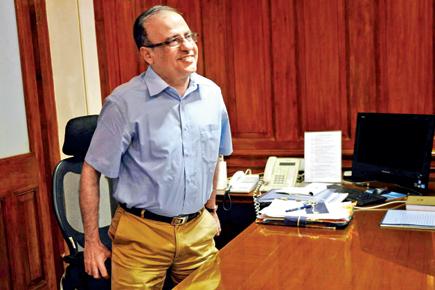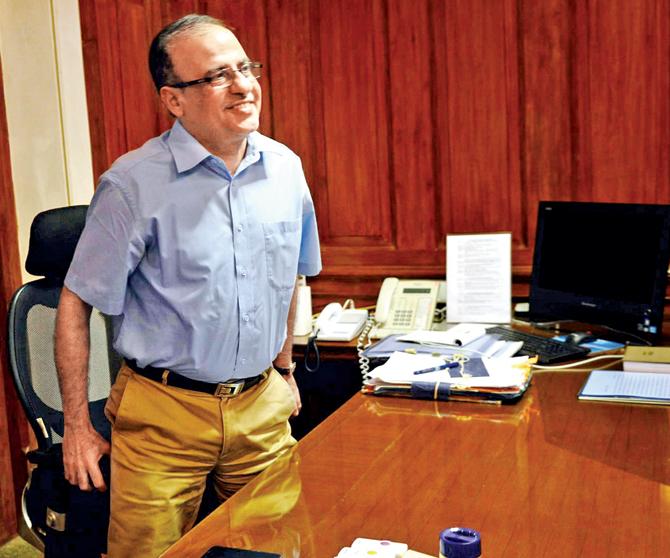BMC chief Ajoy Mehta opens up to Sunday mid-day, in what he says is his first full-length sit-down interview in a career spanning 30 years, about dismantling and reimagining Mumbai

Ajoy Mehta
He might certainly be one of the most powerful men in the city, but he doesn’t have the most enviable job. Absence of N95 masks at JJ Hospital; waterlogging at Hindmata; untreated sewage polluting Malad creek; old tree falling on snazzy car; Ganesh-carrying truck stuck in pothole on highway — he is responsible for it all.
ADVERTISEMENT

Pic/Bipin Kokate
Ajoy Mehta, a 1984 batch IAS officer, took over as commissioner of the Brihanmumbai Municipal Corporation this April from Sitaram Kunte. His inheritance? A controversial Development Plan for the city, trashed by citizens and activists, scrapped by the government.
In what he says is his first full-length sit-down interview in a career spanning 30 years, during which he has served as Collector of Ahmednagar district and Municipal Commissioner of Nasik, he discusses how Mumbai can protect itself even while racing to development.
Q. Many old-timers say Mumbai is no longer liveable. How would you react to that statement?
A. Even so, the quality of civic services in Mumbai rank among the best megacities. Look at our 24x7 power supply, even water supply. Look at safety, law and order, the overall environment we provide in terms of education and healthcare facilities and entertainment. There’s no doubt in my mind that we are one of the best in the country. But, yes, we need to move ahead. And certain problems need urgent addressing, including affordable housing. Housing stock needs to go up. Our fight against diseases like malaria and dengue, solid waste management and cleanliness — these we need to address in partnership with the people. The corporation alone cannot tackle it.
Q. What according to you, as citizen and civic chief, is the city’s prime worry?
A. Public health. We need to better the facilities we offer. And water supply. There continue to be areas that don’t get sufficient water. And then, I’m concerned about the quality of this water. Several of our water supply lines pass through sewers. That’s in the short term. In the long term, transport is an area I’d look at. We are considering the Coastal Road project as an avenue to open up another North-South corridor in a linear city. Sewage management needs addressing too. At the moment, 40 per cent of the city’s waste flows into the sea, untreated. Once you treat it and bring it to tertiary level, it can be reused for cleaning, gardening, so that water can be recirculated and saved. One of the city’s assets is its waterfront. It’s lovely. We need to preserve it.
Q. Is reclamation the only answer? The Coastal Road relies on it. In the late 1800s, bustling commerce due to the Cotton Bubble demanded more space to ease conjestion. This too was addressed by reclamation through the Back Bay Reclamation Scheme.
A. There is a big difference in reclamation done then and now. That one was for constructing homes and commercial buildings. This time around, we are clear that we will do it only to build a road. Whatever open space is created in the process, will be open and remain available to citizens.
Q. Unlike global cities, that are actually a conglomeration of a couple of cities — take Tokyo-Osaka-Yokohama — we haven’t fully developed the Mumbai Metropolitan Region (MMR) into an integrated entity. Where will new land for Mumbai’s development emerge from if not reclamation?
A. We have a lot of new nodes that are developing in MMR, like Panvel. Once the SRA (Slum Rehabilitation Authority) scheme takes off in MMR, it will free up a lot of land. Then, you will move from single storey to high rises; go vertical, in a sense. So, as of now, I don’t see reclamation as an option for developing housing or commercial spaces in Mumbai or MMR.
Q. The Draft Development Plan (DP) 2015-2034 has been marred in controversy. Is there need for a DP for a city where development has already kicked off? The DP then is concerned mostly with No Development Zones (NDZ), redevelopment schemes, and the transport corridors to some extent.
A. Good question. The DP, as you rightly say, is being prepared for a city that’s developed to a great extent. Mumbai is not Greenfield City. Most of Mumbai’s development is a result of redevelopment, so the DP has to look at redevelopment schemes. When you look at redevelopment, you look at new amenities, open spaces and housing. These are the three major challenges that the DP will face. The development control rules (DCR) are also part of the DP, so when you prepare a DP, you must modify the DCR, which then takes into account the changing dynamics of the city. These dynamics could concern population, jobs, new aspirations like better schools closer to home and competent health care. This is what the DP will take care of.
Q. But the argument is, why undertake this futile exercise every 20 years, when the BMC hasn’t been able to implement the previous DP in toto. Why not, instead, simply tweak redevelopment schemes and account for available NDZ?
A. We may not have implemented the previous DP to the extent we should have, but a DP gives you direction. We may not achieve all our goals at once. But we are walking in the right direction. This time, we are also looking at how we will effectively implement it, the innovative methodology that can be used instead of the old tradition of linking the budget to the DP.
Q. The other criticism concerns a bias — that the DP is focussed on urban or town planning in isolation. It does not look at giving Mumbai economic or social impetus.
A. You are right. We are trying to ensure that the commercial and financial pre-eminence of Mumbai is maintained in the DP. We are considering what sort of FSI is needed for commercial areas, what facilities will be provided there. The commercial engine of Mumbai will be retained. The next step is to figure how to house the people who serve this commercial hub. We will look at affordable housing, transportation and quality of life in a comprehensive manner.
Q. Development usually brings with it protest. What about preserving heritage while carrying out development?
A. It’s a given that commercial activity must have an impetus. Also, forty per cent of our population is in the slums. Slum dwellers deserve affordable housing. To give them homes, you may have to indulge in disruption. You may have to look at higher FSI or consider new nodes of development. Or both. Heritage must be preserved, yes. It refers to a ‘common past’. That’s how the dictionary defines it. All of us have a past and we like to protect it. But do you preserve the past at the cost of society or the individual?
Q. The BMC’s biggest stumbling block is its image. It’s seen as synonymous with corruption, both petty corruption and major. The nexus between officials and contractors is notorious. How will you break it?
A. Any tendering process needs safeguards. It must be transparent; it must define what needs to be done, boundaries and goals set. Then, quality control systems need to be in place. Only then will the person who bids and wins will deliver what you sought.
Q. And you think these safeguards are in place?
A. Some, yes. But we need to tighten things. I recently told a gathering of developers that while corruption exists, it starts from the one who agrees to bribe. So, if you decide not to give, and more and more people do the same, there won’t be takers. Once we put systems in place, transparency and predictability will ensure honesty. I urged them not to skirt the system, and go through channels of approval and permission.
 Subscribe today by clicking the link and stay updated with the latest news!" Click here!
Subscribe today by clicking the link and stay updated with the latest news!" Click here!








